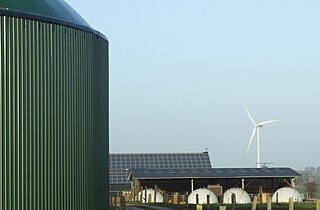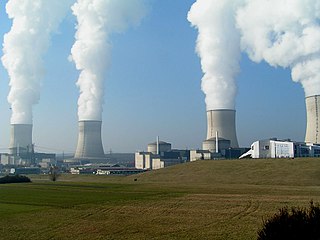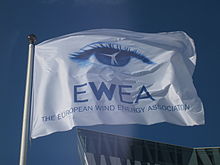
Renewable energy plays an important and growing role in the energy system of the European Union. The Europe 2020 strategy included a target of reaching 20% of gross final energy consumption from renewable sources by 2020, and at least 32% by 2030. The EU27 reached 22.1% in 2020, up from 9.6% in 2004, but declined to 21.8% in 2021. These figures are based on energy use in all its forms across all three main sectors, the heating and cooling sector, the electricity sector, and the transport sector.

Renewable energy in Germany is mainly based on wind and biomass, plus solar and hydro. Germany had the world's largest photovoltaic installed capacity until 2014, and as of 2021 it has over 58 GW. It is also the world's third country by installed total wind power capacity, 64 GW in 2021 and second for offshore wind, with over 7 GW. Germany has been called "the world's first major renewable energy economy".

As of 2023, Europe had a total installed wind capacity of 255 gigawatts (GW). In 2017, a total of 15,680 MW of wind power was installed, representing 55% of all new power capacity, and the wind power generated 336 TWh of electricity, enough to supply 11.6% of the EU's electricity consumption.

Renewable energy in the United Kingdom contributes to production for electricity, heat, and transport.

China is the world leader in wind power generation, with the largest installed capacity of any nation and continued rapid growth in new wind facilities. With its large land mass and long coastline, China has exceptional wind power resources: Wind power remained China's third-largest source of electricity at the end of 2021, accounting for 7.5% of total power generation.

Wind power in Finland has been the fastest growing source of electricity in recent years. In 2022, Finland covered 14.1% of the yearly electricity demand with wind power production, which was 16.7% of the domestic production. Wind capacity was up 76% from the previous year and wind production up 41%. This compares to an average wind power share of 16% in the EU and 17% in the whole of Europe.

Wind power in Romania has total cumulative installed capacity of 3,028 MW as of the end of 2016, up from the 14 MW installed capacity in 2009.

Energy in Finland describes energy and electricity production, consumption and import in Finland. Energy policy of Finland describes the politics of Finland related to energy. Electricity sector in Finland is the main article of electricity in Finland.

Wind power is a growing source of electricity in Poland. In 2019, wind was the second most important source of electricity produced in Poland, after coal, accounting for about 10% of the electricity production.

Wind power in Italy, at the end of 2015, consisted of more than 1,847 wind turbines with a total installed capacity of 8,958 megawatts. Wind power contributed 5.4% of Italy electricity generation in 2015 (14,589 GWh). Italy is ranked as the world's tenth producer of wind power as of the end of 2016. Prospects for Italian wind energy beyond 2020 were positive, with several projects planned to go live before 2030.

Energy in Belgium describes energy and electricity production, consumption and import in Belgium.

The electricity sector in France is dominated by its nuclear power, which accounted for 71.7% of total production in 2018, while renewables and fossil fuels accounted for 21.3% and 7.1%, respectively. France has the largest share of nuclear electricity in the world, and together with renewable energy supplies, this has helped its grid achieve very low carbon intensity.

Electricity sector in Luxembourg describes electricity issues in Luxembourg. Luxembourg is a member of OECD and European Union. Luxembourg imports most of its energy. Luxembourg is the EU country with the second smallest forecast of renewables in 2020. Luxembourg has one of the highest emissions of carbon dioxide per person in Europe.
Electricity sector in Estonia is connected to Finland, Russia and the other Baltic countries. As of 2016, it was one of the dirtiest in the EU in terms of CO2 emissions, as oil-based fuels accounted for about 80% of domestic production. However, renewables had grown to over 13% of production whereas they were less than 1% in 2000. Thus, Estonia is one of the countries to have reached its EU renewable target by 2016.
The Polish energy sector is the fifth largest in Europe. In 2022, the country consumed 13.16 TWh of electricity, importing 3 114 GWh thereof.

Energy in Greece is dominated by fossil gas and oil. Electricity generation is dominated by the one third state owned Public Power Corporation. In 2009 DEI supplied for 85.6% of all electric energy demand in Greece, while the number fell to 77.3% in 2010. Almost half (48%) of DEI's power output in 2010 was generated using lignite. 12% of Greece's electricity comes from hydroelectric power plants and another 20% from natural gas. Between 2009 and 2010, independent companies' energy production increased by 56%, from 2,709 Gigawatt hour in 2009 to 4,232 GWh in 2010.
Energy in Europe includes energy and electricity production, consumption and import in Europe.

Despite the historic usage of wind power to drain water and grind grain, the Netherlands today lags 21 of the 26 other member states of the European Union in the consumption of energy from renewable sources. In 2022, the Netherlands consumed just 15% of its total energy from renewables. According to statistics published by Eurostat, it was the last among the EU countries in the shift away from global warming-inducing energy sources. The leading renewable sources in the country are biomass, wind, solar and both geothermal and aerothermal power. In 2018 decisions were made to replace natural gas as the main energy source in the Netherlands with increased electrification being a major part of this process.
Renewable energy in the Czech Republic describes the renewable energy related development in the Energy in the Czech Republic.

Hungary is a member of the European Union and thus takes part in the EU strategy to increase its share of renewable energy. The EU has adopted the 2009 Renewable Energy Directive, which included a 20% renewable energy target by 2020 for the EU. By 2030 wind should produce in average 26-35% of the EU's electricity and save Europe €56 billion a year in avoided fuel costs. The national authors of Hungary forecast is 14.7% renewables in gross energy consumption by 2020, exceeding their 13% binding target by 1.7 percentage points. Hungary is the EU country with the smallest forecast penetration of renewables of the electricity demand in 2020, namely only 11%.
















